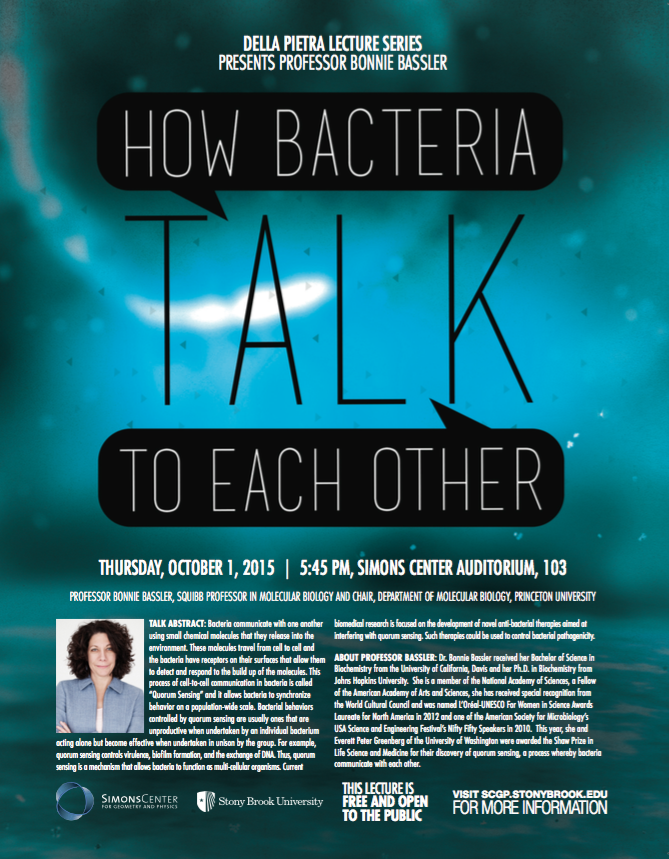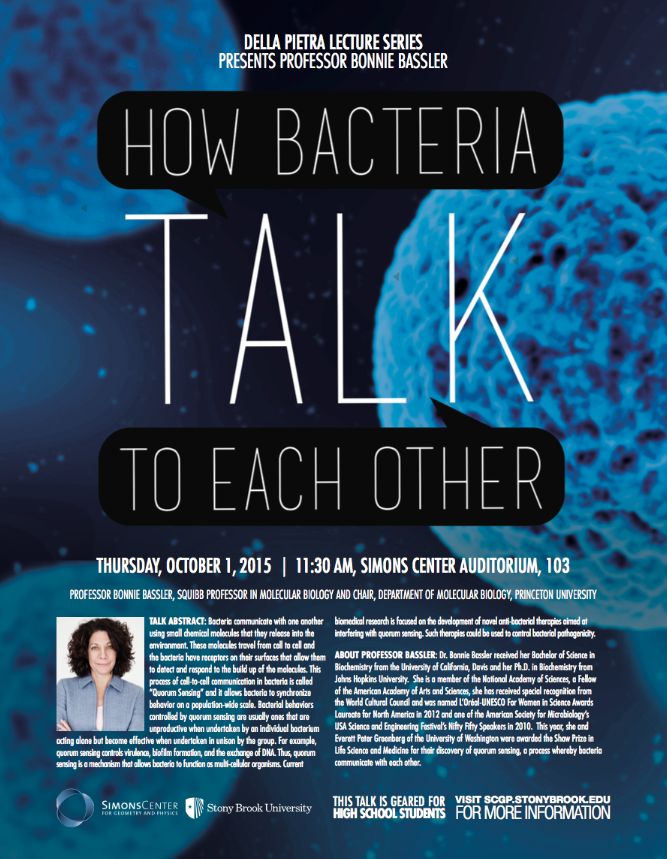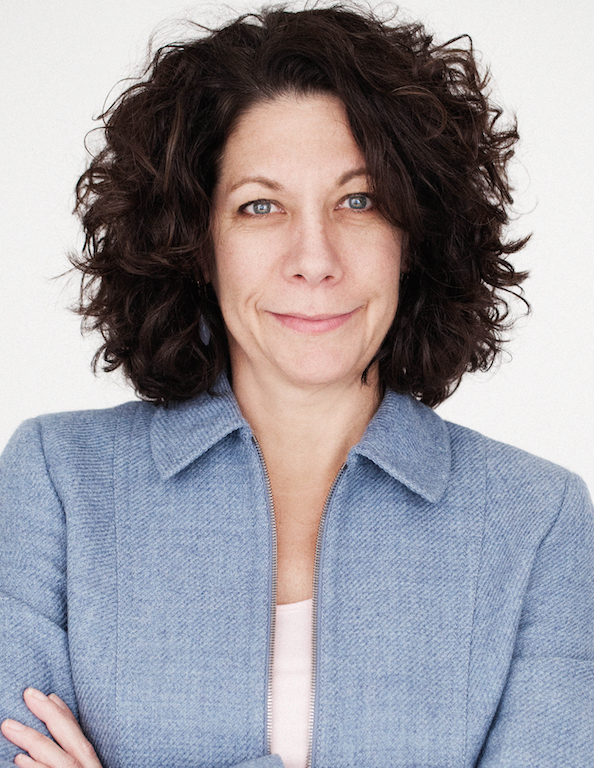 General Public Lecture
General Public Lecture
Thursday, October 1, 2015
Wine and Cheese Reception: 5:00 pm, Simons Center Lobby and Art Gallery
Lecture: 5:45 pm, Simons Center Auditorium, Room 103
Title: “How Bacteria Talk To Each Other”
Abstract:
Bacteria communicate with one another using small chemical molecules that they release into the environment. These molecules travel from cell to cell and the bacteria have receptors on their surfaces that allow them to detect and respond to the build up of the molecules. This process of cell-to-cell communication in bacteria is called “Quorum Sensing” and it allows bacteria to synchronize behavior on a population-wide scale. Bacterial behaviors controlled by quorum sensing are usually ones that are unproductive when undertaken by an individual bacterium acting alone but become effective when undertaken in unison by the group. For example, quorum sensing controls virulence, biofilm formation, and the exchange of DNA. Thus, quorum sensing is a mechanism that allows bacteria to function as multi-cellular organisms. Current biomedical research is focused on the development of novel anti-bacterial therapies aimed at interfering with quorum sensing. Such therapies could be used to control bacterial pathogenicity.
 Technical Talk for Faculty and Advanced Graduate Students
Technical Talk for Faculty and Advanced Graduate Students
Friday, October 2, 2015
Lecture: 11:00 am, Simons Center Lecture Hall, Room 102
Title: “Bacterial Quorum Sensing and its Control”
Abstract:
Bacteria communicate with one another via the production and detection of secreted signal molecules called autoinducers. This cell-to-cell communication process, called “Quorum Sensing”, allows bacteria to synchronize behavior on a population-wide scale. Behaviors controlled by quorum sensing are usually ones that are unproductive when undertaken by an individual bacterium acting alone but become effective when undertaken in unison by the group. For example, quorum sensing controls virulence factor production, biofilm formation, and the excretion of public goods such an enzymes that solubilize solid food sources making them accessible for consumption. We developed small molecule quorum-sensing agonists and antagonists to discover the principles underlying the exquisite selectivity quorum-sensing receptors have for their cognate ligands. Our results suggest mechanisms bacteria use in the wild to ensure the proper ligand has interacted with its partner receptor prior to eliciting signal transduction. We suggest that, in their native environments, bacteria encounter mixtures of autoinducers produced by other species occupying the same niche. Precise autoinducer discrimination enables a particular species of bacteria to respond exclusively to its own signal even in the face of fierce competition. This ability prevents the leakage of benefits of quorum-sensing-controlled public goods to non-kin.
 Special Presentation for High School Students
Special Presentation for High School Students
Thursday, October 1, 2015
Lecture: 11:30 am, Simons Center Auditorium, Room 103
Title: “How Bacteria Talk To Each Other”
Abstract
Bacteria communicate with one another using small chemical molecules that they release into the environment. These molecules travel from cell to cell and the bacteria have receptors on their surfaces that allow them to detect and respond to the build up of the molecules. This process of cell-to-cell communication in bacteria is called “Quorum Sensing” and it allows bacteria to synchronize behavior on a population-wide scale. Bacterial behaviors controlled by quorum sensing are usually ones that are unproductive when undertaken by an individual bacterium acting alone but become effective when undertaken in unison by the group. For example, quorum sensing controls virulence, biofilm formation, and the exchange of DNA. Thus, quorum sensing is a mechanism that allows bacteria to function as multi-cellular organisms. Current biomedical research is focused on the development of novel anti-bacterial therapies aimed at interfering with quorum sensing. Such therapies could be used to control bacterial pathogenicity.
 Dr. Bonnie Bassler is the Squibb Professor in Molecular Biology and Chair, Department of Molecular Biology at Princeton University. She received her Bachelor of Science in Biochemistry from the University of California, Davis and her P.h.D. in Biochemistry from Johns Hopkins University. Dr. Bassler is a member of the National Academy of Sciences and a Fellow of the American Academy of Arts and Sciences; she has received special recognition from the World Cultural Council and was named L’Oreal-UNESCO For Women in Science Awards Laureate for North America in 2012 and one of the American Society for Microbiology’s USA Science and Engineering Festivals’ Nifty Fifty Speakers in 2010. This year, Professor Bassler and Everett Peter Greenberg of the University of Washington were awarded the Shaw Prize in Life Science and Medicine for their discovery of quorum sensing, a process whereby bacteria communicate with each other.
Dr. Bonnie Bassler is the Squibb Professor in Molecular Biology and Chair, Department of Molecular Biology at Princeton University. She received her Bachelor of Science in Biochemistry from the University of California, Davis and her P.h.D. in Biochemistry from Johns Hopkins University. Dr. Bassler is a member of the National Academy of Sciences and a Fellow of the American Academy of Arts and Sciences; she has received special recognition from the World Cultural Council and was named L’Oreal-UNESCO For Women in Science Awards Laureate for North America in 2012 and one of the American Society for Microbiology’s USA Science and Engineering Festivals’ Nifty Fifty Speakers in 2010. This year, Professor Bassler and Everett Peter Greenberg of the University of Washington were awarded the Shaw Prize in Life Science and Medicine for their discovery of quorum sensing, a process whereby bacteria communicate with each other.
All of these lectures were made possible by a generous donation from the Della Pietra family. The Della Pietra Lecture Series aims to bring world-renowned scientists to the Simons Center for Geometry and Physics to enhance the intellectual activity of the Center and also bring greater awareness of recent and impactful discoveries in Physics and Mathematics to the Long Island community.
For more information visit scgp.stonybrook.edu or call 631-632-2800.

